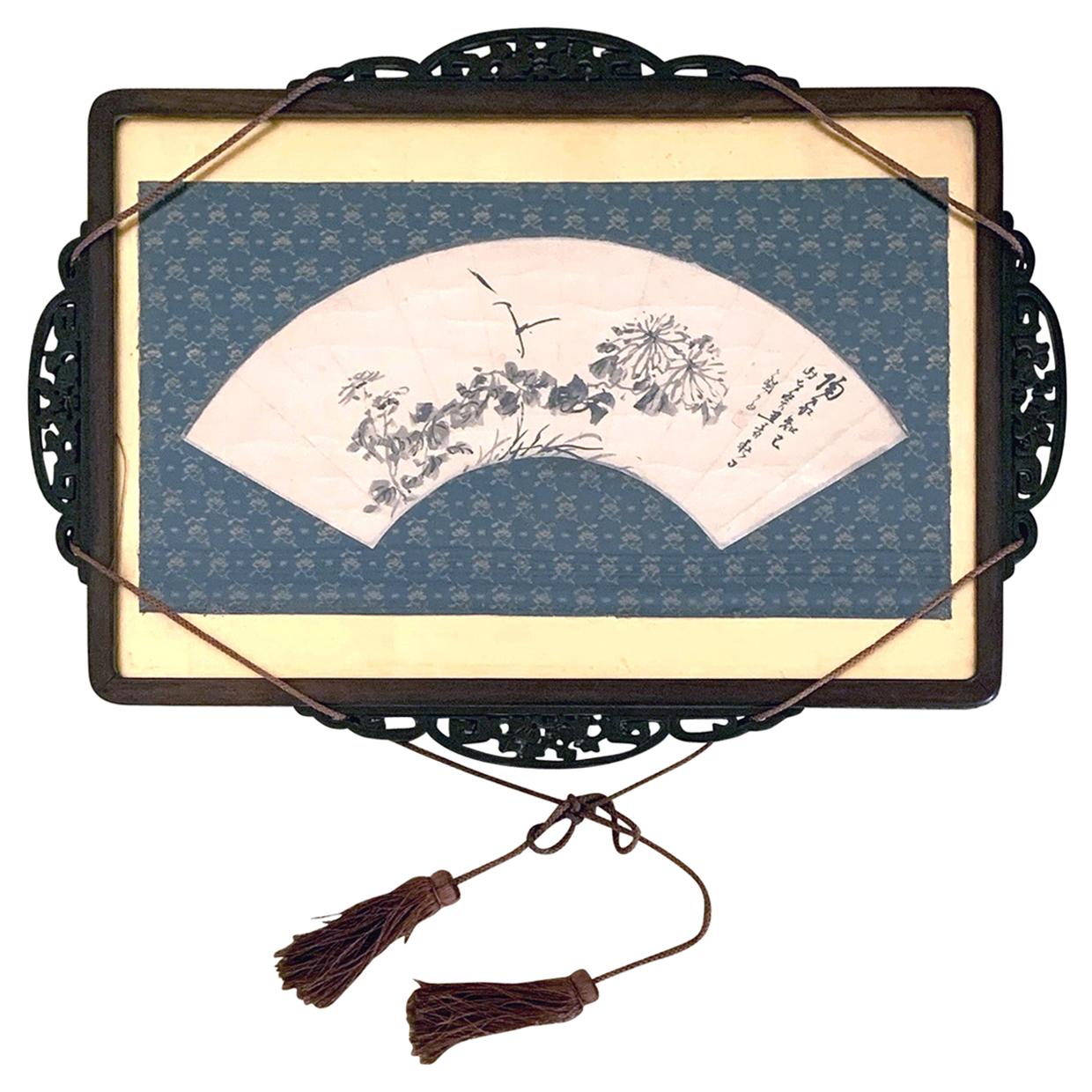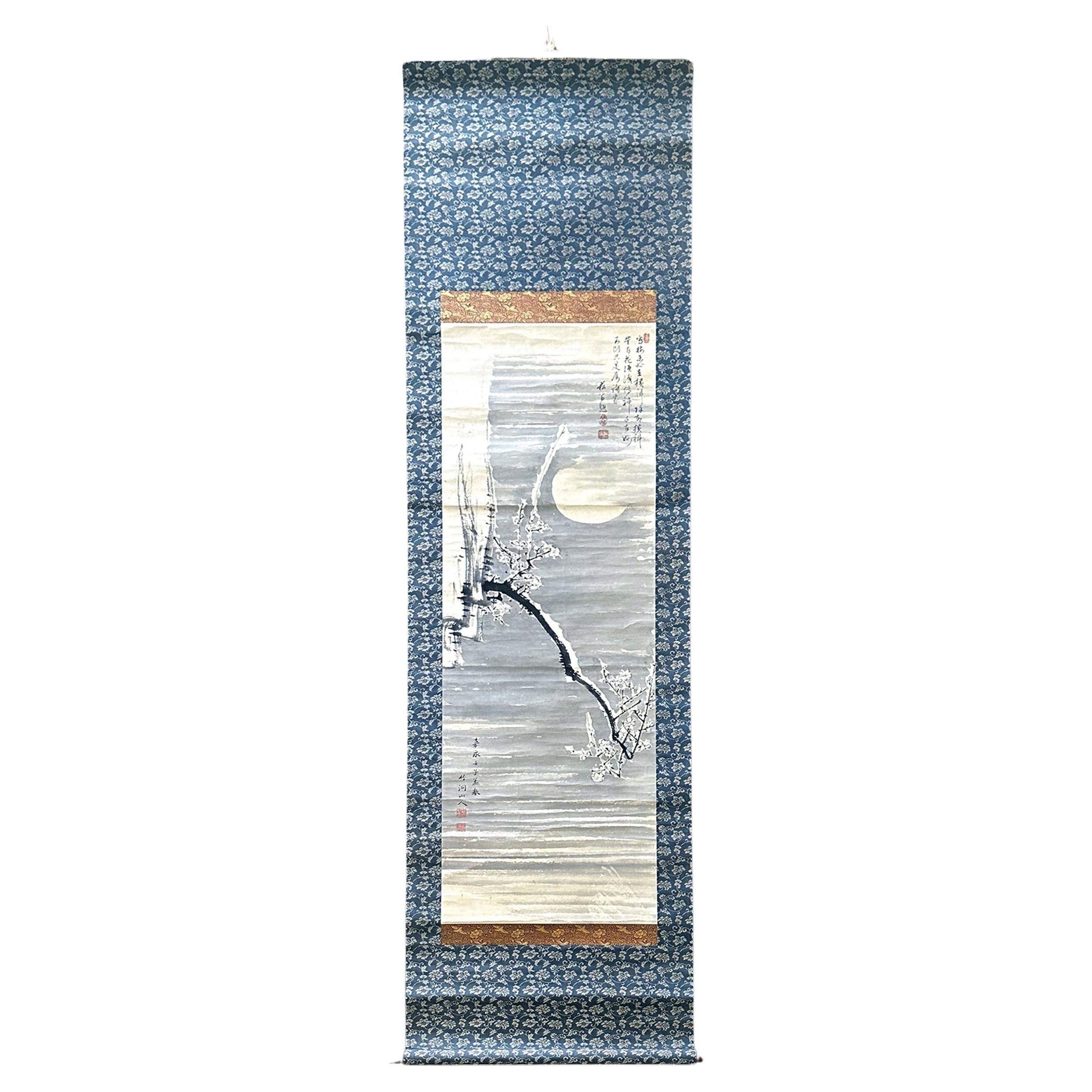Items Similar to Antique Japanese Ink Hanging Scroll Hidaka Tetsuo with Wood Storage Box
Want more images or videos?
Request additional images or videos from the seller
1 of 15
Antique Japanese Ink Hanging Scroll Hidaka Tetsuo with Wood Storage Box
About the Item
A hanging ink (Sumi-e) silk scroll by Japanese Zen artist Hidaka Tetsuo (1791-1871). Well presented in brocade boarders and mounted on paperback, this scroll depicts "Three Noble Friends in Winter" in a poetic and novel way. One of the favorite subjects by Chinese painters, the three noble friends in winter consists of pine, bamboo and plum flowers. They were admired for their characters of strength in cold resistance to remain evergreen and even blossom in unfavorable condition. The artist, however, composited the subjects in a none-conventional way as Ikebana. Bamboo and flowering plum branches were presented in an oversized pot. The pine, curiously, seems to be absent at first, but a closer look sees a branched plant at the foot of the pot that resembles a small pine, but also with a morphed appearance of "Lingzhi" mushroom, the symbol of longevity. It appears to be the artist's intention to expose the symbolism by transcending the reality of imagery.
The scroll was signed with title and name in cursive Kanji and marked with two artist's red seals. Image is 49" x 18". The full length of the scroll measure 80" x 26". A later customed collector box retains the collector's label in both Kanji and English as shown.
Tetsuo was a monk of Zen-sect who painted in Chinese ink style. He was born in Nagasaki and studied painting under Yushi Ishizaki and Kaho Koh. He was known as one of the three great painters in Nagasaki prefecture (the other two are Gomon Miura and Itsuun Kinoshita). Similar ink painting on fans by the artist are held in the collection of Seattle Art Museum (92.47.323.15) and British Museum (1973.0226.0.91 and 1973.0226.0.89).
- Creator:Hidaka Tetsuo (Artist)
- Dimensions:Height: 3.5 in (8.89 cm)Width: 27 in (68.58 cm)Depth: 3 in (7.62 cm)
- Style:Japonisme (Of the Period)
- Materials and Techniques:
- Place of Origin:
- Period:
- Date of Manufacture:19th Century
- Condition:Wear consistent with age and use. Fine condition, some surface wrinkles expected from the medium/mount.
- Seller Location:Atlanta, GA
- Reference Number:1stDibs: LU945028247172
About the Seller
5.0
Platinum Seller
These expertly vetted sellers are 1stDibs' most experienced sellers and are rated highest by our customers.
Established in 2006
1stDibs seller since 2010
479 sales on 1stDibs
Typical response time: <1 hour
- ShippingRetrieving quote...Ships From: Atlanta, GA
- Return PolicyA return for this item may be initiated within 2 days of delivery.
More From This SellerView All
- Framed Japanese Ink Painting Hidaka TetsuoBy Hidaka TetsuoLocated in Atlanta, GAAn ink painting on the fan surface by Japanese Zen artist Hidaka Tetsuo (1791-1871), now framed in a traditional Japanese carved wood frame with silk fabric mat and decorative hangin...Category
Antique 1850s Japanese Japonisme Paintings and Screens
MaterialsWood, Paper
- Antique Japanese Ink Hanging Scroll Nakabayashi Chikuto Edo PeriodBy Hidaka TetsuoLocated in Atlanta, GAAn ink painting on paper (Sumi-e) mounted with brocade borders as a hanging scroll. Entitled "Plum Blossom Under a Misty Moon", the artist was Japanese painter Nakabayashi Chikuto (1...Category
Antique 19th Century Japanese Japonisme Paintings and Screens
MaterialsBrocade, Wood, Paper
- Pair of Japanese Ink Hanging Scrolls Kano TanyuBy Kano Tan'yu 1Located in Atlanta, GAA fine matching pair of hanging scrolls ink on paper mounted in green brocade borders circa Edo period (17-18th century). The Kano school painting depicts wild geese in the reeds by the margin of water, a popular subject borrowed from the Chinese tradition. Both painting were signed as Tanyu with a red seal of Morinobu, his birth name. The storage box is also present and was inscribed with the title Painting of Geese and Reeds and Kano Tanyu...Category
Antique Late 17th Century Japanese Japonisme Paintings and Screens
MaterialsWood, Paper
- Two Antique Japanese Hanging Scroll PaintingsLocated in Atlanta, GATwo Japanese scroll painting depicts scenes from the Tale of Genji (Genji-E), from Edo period. These painting were purchased from Odewara Shoten in the...Category
Antique Early 19th Century Japanese Japonisme Paintings and Screens
MaterialsBrocade, Paper
- Antique Japanese Hanging Scroll Attributed to Iwasa MatabeiLocated in Atlanta, GAAn antique ink and color on paper hanging scroll (kakejiku) with brocade border. It appears to be a fragment of a larger hand scroll depicting a procession of a lord with his entoura...Category
Antique Early 17th Century Japanese Japonisme Paintings and Screens
MaterialsSilk, Paper
- Large Antique Zen Japanese Ink Scroll After Sesson ShukeiLocated in Atlanta, GAA Japanese Sumi ink painting with light color wash mounted with brocade borders as a hanging scroll (Kakejiku). The painting depicts the famously eccentric Buddhist monks Hanshan and Shide (known in Japan as Kanzan and Jittoku). Often as a pair, they have been a popular motif in Japanese Zen painting...Category
Antique 18th Century Japanese Japonisme Paintings and Screens
MaterialsSilk, Paper
You May Also Like
- Set of Four Japanese Silk Hanging Scrolls Screens C.1920Located in London, GBA stunning set of four Japanese silk mounted vertical hanging scrolls. Dating from C.1920 Taisho Period. The watercolour and ink on silk depicts a larg...Category
Vintage 1920s Japanese Japonisme Paintings and Screens
MaterialsSilk
- Hanging Scroll by Kamisaka Sekka, JapanLocated in Milano, ITThis painting represents a man waiting under a dark tree. The composition is extremely simple but suggestive. The artist, with few elements, can, in fact, create a vivid and dynamic scene, based on the tension between the strong ink stain that renders the tree and the elegant figure of the man, dressed in an aristocratic robe. Painter and designer, Kamisaka Sekka...Category
Early 20th Century Japanese Paintings and Screens
MaterialsPaper
- Antique hanging scroll of Japanese cat/Late Edo-Meiji period/Cat paintingLocated in Sammu-shi, ChibaThis is a picture of a cat drawn by a person named "Toshizumi Nitta" from the end of the Edo period to the beginning of the Meiji period. She is a very simple and cute cat. He is a vassal of the Tokugawa Shogunate, born in Ota City, Gunma Prefecture (southern part of Gunma Prefecture). He was related to the Tokugawa family and lived in a large mansion in the Ota clan in Gunma prefecture. However, the Nitta family's territory was very small, and they were by no means a wealthy vassal. He seems to have lived quite poorly. So he painted cats and sold them to people. The Nitta family continued to draw pictures of this cat for four generations. "Nitta toshizumi" is equivalent to the fourth generation. During the Edo period, sericulture was thriving in the Kanto region. Cats were said to be the gods of silkworms, as they drive away mice, the natural enemies of silkworms. It was the Nitta family who drew such a cat on paper, pasted it in the silkworm chamber, and sold it as a mouse repellent. There were also other monks who painted pictures of cats, but the Nitta family in particular was related to the Tokugawa family, so people believed that paintings of cats had special powers. , a lot of paintings...Category
Antique Late 19th Century Japanese Edo Paintings
MaterialsPaper
- Japanese Painting, Hanging Scroll, Circa 1930, Amaranth and RoosterLocated in Kyoto, JPAmaranth and Rooster Artist unknown Hanging scroll, ink, mineral pigment and gofun on silk. Painting inscription: Tojo ?? Painting seal: Tojo ?? circa 1930 Dimensions: Scroll:...Category
Early 20th Century Japanese Taisho Paintings and Screens
MaterialsSilk
- Japanese Painting, Hanging Scroll, 19th Century Bamboo in MoonlightLocated in Kyoto, JPBamboo in moonlight Gamo Rakan (1784-1866) Hanging scroll, ink on silk. Dimensions: Scroll: 201 cm x 58 cm Image: 137 cm x 45 cm In this early 19th century work by Gamo Rakan a light ink wash applied to the silk background silhouettes the moon and suggests the atmosphere of early evening. Even though it is a literati subject, Rakan’s bamboo is quite realistic with a strong decorative style. The painting finds its inspiration from Chinese Ming dynasty painters who often used a single-tone, jet black stroke to emphasize the calligraphic nature of bamboo. In a different era, decorative would have been seen as somewhat unrefined. But increasingly in the Edo period, it was the hallmark of high style. The Japanese people, in particular the rising merchant class, had gradually become apathetic toward the traditional Sesshu and Kano schools of painting. Chinese professional and amateur painters living in the port of Nagasaki during the 18th century had a profound effect on Japanese painting and the freshness of their style and its decorative appeal contributed greatly to its popularity. Gamo Rakan’s teacher, Tani Buncho...Category
Antique Early 19th Century Japanese Edo Paintings and Screens
MaterialsSilk
- 260 Year Old Japanese Hanging Scroll with Painting of the 9-Headed Dragon DeityLocated in Amsterdam, NLAmazing 260 year old Japanese kakejiku (hanging scroll) with a refined painting of the nine headed dragon deity, with a Buddhist flame as a crown, an...Category
Antique Mid-18th Century Japanese Paintings and Screens
MaterialsMetal





